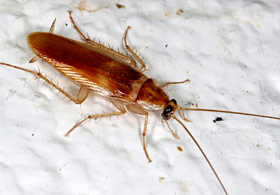Brownbanded Cockroach, Supella longipalpa

Gary Alpert, Harvard University, Bugwood.org.
IPM Steps to Reduce Brownbanded Cockroaches
1. Sample for Pest
Confirm the presence of cockroaches.
Where to find it while inspecting: You will need a strong flashlight and an inspection size mirror (small and on a long handle) to do the job properly. Draw a diagram map of the area. To monitor activity, you can place sticky traps in areas where you suspect activity. It’s a good idea to mark the date you set the trap and also to note the location on your map. You are most likely to find Brownbanded cockroaches in warm, dry areas up high instead of under and behind sinks and appliances. (They can be a building-wide pest rather than show a preference for kitchens and baths. You will also see “pepper-like” specks on walls near nest sites (feces). Nymphs cast off their “skin” as they grow and this is another sign of cockroach infestation. The use of sticky traps at strategic locations is helpful; place in out of the way locations and monitor regularly.
2. Proper ID
Before you act, determine your pest is a cockroach and for best results, which species of cockroach.
Size and Particulars: Flattened, oval shaped insects with long legs and antennae, and wings (though they don’t fly). 1" light brown. Light-colored bands on wings of both adult sexes are more noticeable in nymphs.
3. Learn the Pest Biology
Knowing the life cycle helps you fight cockroach infestations.
Life Cycle: Brownbanded cockroaches produce large numbers of eggs and have the shortest time from hatch to sexual maturity. Females glue egg capsule to surfaces such as doors, furniture, closet walls. Females produce egg capsules around fourteen times in her life, averaging 13 eggs per capsule. (It is estimated that a female can produce 600 descendants during her lifetime).
Preferred Food Sources: Brownbanded cockroaches feed on a variety of materials including our food, plus starches, dyes, and non-food items such as books, stamps, and clothing.
Preferred Habitat: Brownbanded cockroaches prefer warmth and tend to be up away from the floor in closets or in heat-generating appliances. They are active at night and during the day will seek out their warm, dark places. Cockroaches in general are good climbers.
4. Determine Threshold
If you have cockroaches, you need to act.
Threshold: One cockroach almost always means more are unseen.
5. Choose Tactics
IPM for indoor pests is always a combination of exclusion and sanitation: Don’t provide access to water, food and shelter!
Best Management Practices: The key factor is sanitation and reduction in habitat. Take care not to bring them in on packaging material (inspect incoming food). Clean up all spilled foods; don’t leave dirty dishes overnight; store all food in pest-resistant packaging; modify areas where pipes and utilities enter walls (caulk and screen all entrances); reduce moisture by improving plumbing and insulating pipes that routinely sweat. Empty garbage every day. Baits are the most efficient and widely used form of control, but prevention is the least toxic method of control.
Treatment Methods: Chemical control: Baits contain hydramethylnon, fipronil, sulfluramide, boric acid and abamectin can provide acceptable control. Read the label carefully before using and keep out of reach of children. Insecticidal dusts like boric acid, silica aerogel and diatomaceous can also provide control. Light applications of dust in cracks and crevices can be made, but not in areas where children have access. Baits kill actively feeding nymphs and adults but not eggs so this method will have to be maintained over a period of time. NOTE: the use of insecticide sprays and foggers is rarely effective. NOTE: boric acid can be a hazard to children if within their reach. The long egg-hatching time means treatments must be ongoing until all signs of infestations are gone. Continue to use sticky traps to monitor activity and check them often.
6. Evaluate
Was the tactic successful? Record the date pests were first noted, and the tactic you used, and its success. Use one of our RECORD KEEPING tools.
For More Information:
Main.gov Got Pests?: Cockroaches
Integrated Pest Management for Northeast Schools
Found a Cockroach? Saw a Gazillion?
Remember:
When a pesticide application is necessary, all necessary and required precautions are taken to minimize risk to people and the environment and to minimize risk of pesticide resistance or pest resurgence. Pesticide use in your school may be prohibited or regulated by local policies or state and federal regulations. Risk reduction methods can include, but are not limited to, spot-treatment, the use of gel or paste bait formulations placed in inaccessible locations, injection into a crack or crevice, and other methods that reduce potential exposure.